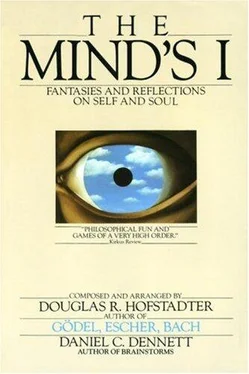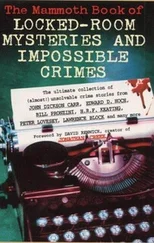The account of the origin of life which I shall give is necessarily speculative; by definition, nobody was around to see what happened. There are a number of rival theories, but they all have certain features in common. The simplified account I shall give is probably not too far from the truth.
We do not know what chemical raw materials were abundant on earth before the coming of life, but among the plausible possibilities are water, carbon dioxide, methane, and ammonia: all simple compounds known to be present on at least some of the other planets in our solar system. Chemists have tried to imitate the chemical conditions of the young earth. They have put these simple substances in a flask and supplied a source of energy such as ultraviolet light or electric sparks—artificial simulation of primordial lightning. After a few weeks of this, something interesting is usually found inside the flask: a weak brown soup containing a large number of molecules more complex than the ones originally put in. In particular, amino acids have been found—the building blocks of proteins, one of the two great classes of biological molecules. Before these experiments were done, naturally occurring amino acids would have been thought of as diagnostic of the presence of life. If they had been detected on, say, Mars, life on that planet would have seemed a near certainty. Now, however, their existence need imply only the presence of a few simple gases in the atmosphere and some volcanoes, sunlight, or thundery weather. More recently, laboratory simulations of the chemical conditions of earth before the coming of life have yielded organic substances called purines and pyrimidines. These are building blocks of the genetic molecule, DNA itself.
Processes analogous to these must have given rise to the “primeval soup” which biologists and chemists believe constituted the seas some three to four thousand million years ago. The organic substances became locally concentrated, perhaps in drying scum round the shores, or in tiny suspended droplets. Under the further influence of energy such as ultraviolet light from the sun, they combined into larger molecules. Nowadays large organic molecules would not last long enough to be noticed: they would be quickly absorbed and broken down by bacteria or other living creatures. But bacteria and the rest of us are late-comers, and in those days large organic molecules could drift unmolested through the thickening broth.
At some point a particularly remarkable molecule was formed by accident. We will call it the Replicator. It may not necessarily have been the biggest or the most complex molecule around, but it had the extraordinary property of being able to create copies of itself. This may seem a very unlikely sort of accident to happen. So it was. It was exceedingly improbable. In the lifetime of a man, things which are that improbable can be treated for practical purposes as impossible. That is why you will never win a big prize on the football pools. But in our human estimates of what is probable and what is not, we are not used to dealing in hundreds of millions of years. If you filled in pools coupons every week for a hundred million years you would very likely win several jackpots.
Actually a molecule which makes copies of itself is not as difficult to imagine as it seems at first, and it only had to arise once. Think of the replicator as a mold or template. Imagine it as a large molecule consisting of a complex chain of various sorts of building block molecules. The small building blocks were abundantly available in the soup surrounding the replicator. Now suppose that each building block has an affinity for its own kind. Then whenever a building block from out in the soup lands up next to a part of the replicator for which it has an affinity, it will tend to stick there. The building blocks which attach themselves in this way will automatically be arranged in a sequence which mimics that of the replicator itself. It is easy then to think of them joining up to form a stable chain just as in the formation of the original replicator. This process could continue as a progressive stacking up, layer upon layer. This is how crystals are formed. On the other hand, the two chains might split apart, in which case we have two replicators, each of which can go on to make further copies.
A more complex possibility is that each building block has affinity not for its own kind, but reciprocally for one particular other kind. Then the replicator would act as a template not for an identical copy, but for a kind of “negative,” which would in its turn remake an exact copy of the original positive. For our purposes it does not matter whether the original replication process was positive-negative or positive-positive, though it is worth remarking that the modern equivalents of the first replicator, the DNA molecules, use positive-negative replication. What does matter is that suddenly a new kind of “stability” came into the world. Previously it is probable that no particular kind of complex molecule was very abundant in the soup, because each was dependent on building blocks happening to fall by luck into a particular stable configuration. As soon as the replicator was born it must have spread its copies rapidly throughout the seas, until the smaller building block molecules became a scarce resource, and other larger molecules were formed more and more rarely.
So we seem to arrive at a large population of identical replicas. But now we must mention an important property of any copying process: it is not perfect. Mistakes will happen. I hope there are no misprints in this book, but if you look carefully you may find one or two. They will probably not seriously distort the meaning of the sentences, because they will be “first-generation” errors. But imagine the days before printing, when books such as the Gospels were copied by hand. All scribes, however careful, are bound to make a few errors, and some are not above a little willful “improvement.” If they all copied from a single master original, meaning would not be greatly perverted. But let copies be made from other copies, which in their turn were made from other copies, and errors will start to become cumulative and serious. We tend to regard erratic copying as a bad thing, and in the case of human documents it is hard to think of examples where errors can be described as improvements. I suppose the scholars of the Septuagint could at least be said to have started something big when they mistranslated the Hebrew word for “young woman” into the Greek word for “virgin,” coming up with the prophecy: “Behold a virgin shall conceive and bear a son....” Anyway, as we shall see, erratic copying in biological replicators can in a real sense give rise to improvement, and it was essential for the progressive evolution of life that some errors were made. We do not know how accurately the original replicator molecules made their copies. Their modern descendants, the DNA molecules, are astonishingly faithful compared with the most high-fidelity human copying process, but even they occasionally make mistakes, and it is ultimately these mistakes which make evolution possible. Probably the original replicators were far more erratic, but in any case we may be sure that mistakes were made, and these mistakes were cumulative.
As mis-copyings were made and propagated, the primeval soup became filled by a population not of identical replicas, but of several varieties of replicating molecules, all “descended” from the same ancestor. Would some varieties have been more numerous than others? Almost certainly yes. Sonic varieties would have been inherently more stable than others. Certain molecules, once formed, would be less likely than others to break tip again. These types would become relatively numerous in the soup, not only as a direct logical consequence of their “longevity,” but also because they would have a long time available for making copies of themselves. Replicators of high longevity would therefore tend to become more numerous and, other things being equal, there would have been an “evolutionary trend” toward greater longevity in the population of molecules.
Читать дальше











